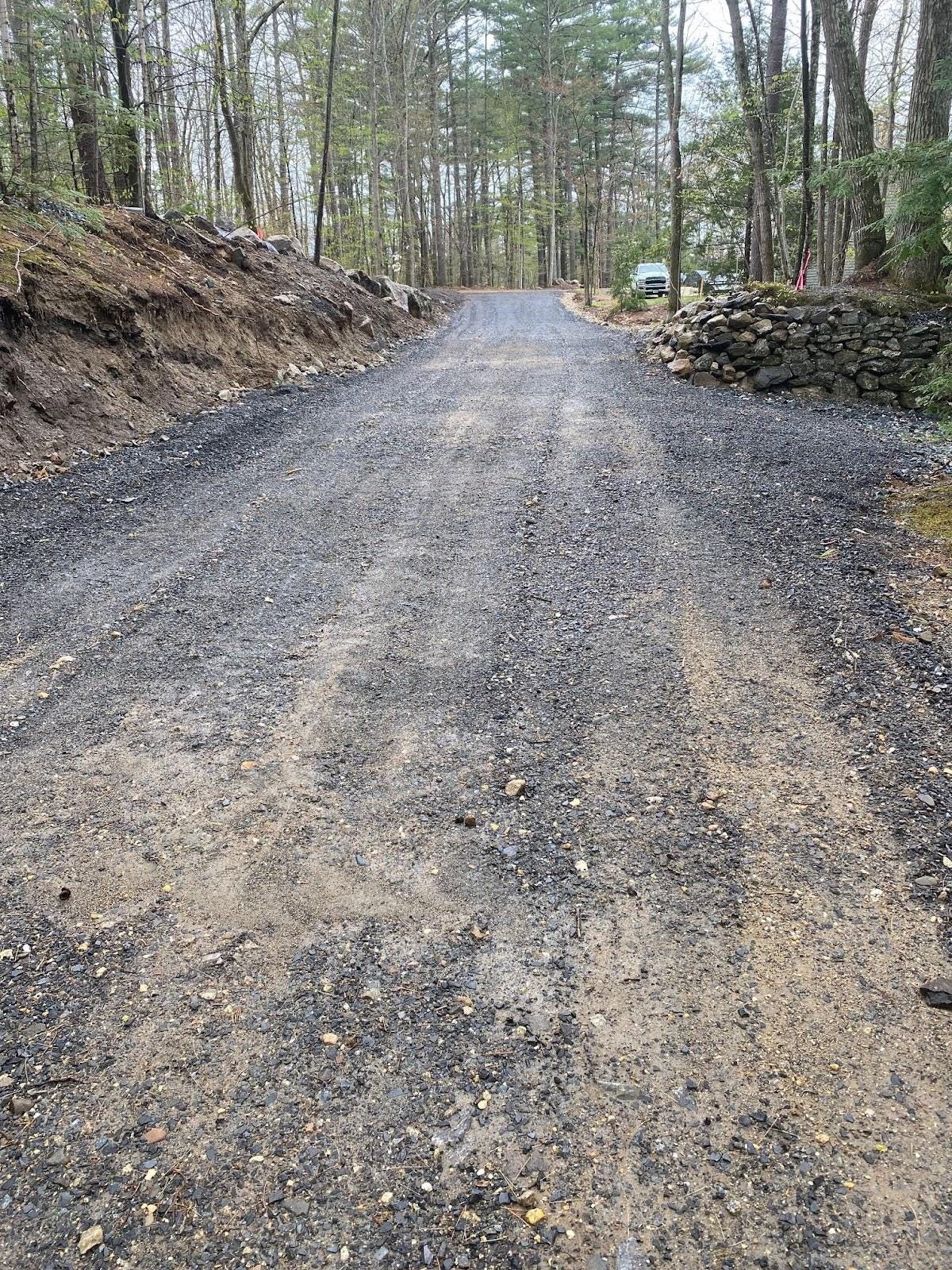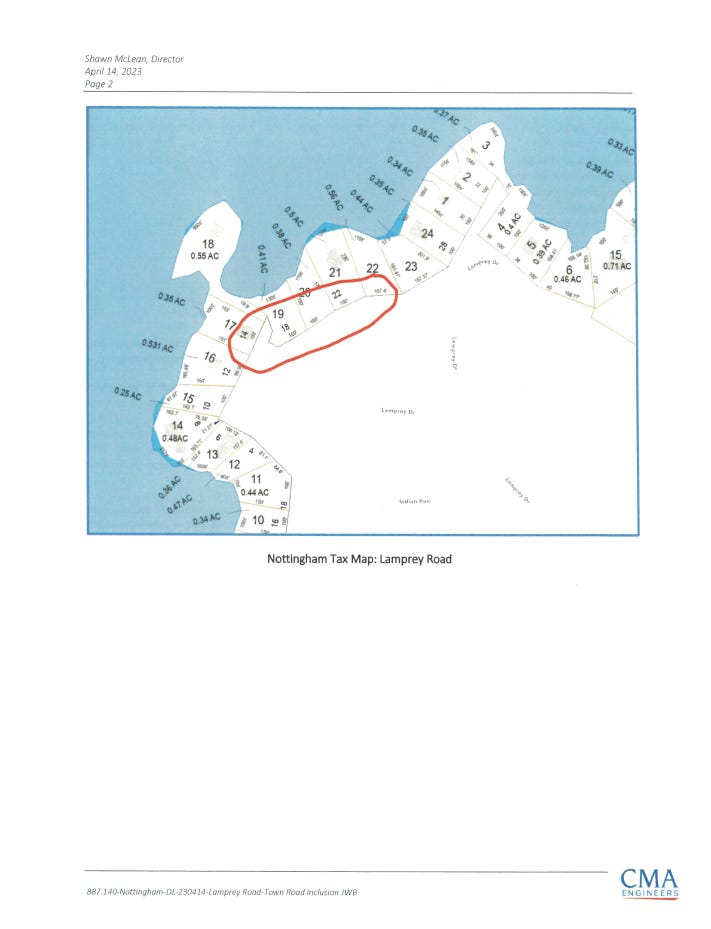Lamprey Drive Engineering Assessment
Engineering firm’s report contains no assessment but plenty of errors.
At the May 1 Board of Selectmen meeting the Town Administrator said the Director of Public Works had advised the board to reject, based on the assessment provided by CMA Engineers, the 60-yard section of Lamprey Drive that residents had constructed at their own expense* - $18k - to link the disconnected pieces of Lamprey Drive.
This issue about Lamprey Drive has repeatedly come before the board, being discussed on July 25, August 8, September 12, and February 27. The origin of the issue was that the town wanted to break up Lamprey Drive into several newly named roads for e-911 reasons. Residents pointed out that this would be unnecessary if the unconstructed section of Lamprey Drive were to be built. The petitioners say this section of road had been approved by the town in the early 1960s. It appears on some older town maps. It had not been constructed earlier because the owners of two lots failed to build their portion of Lamprey Drive. The deeds obliged the owners to construct the section of road on their lots when their lots were developed. One of these lots has never been developed. The other lot was developed long after the 1960s and the town failed to enforce the deed’s requirement.
The petitioners sent me the assessment from CMA Engineers. No wonder Selectman John Morin objected to the contents of the report at the board meeting, causing the issue to be tabled to the next meeting to have the Director of Public Works on hand to discuss the matter.
The document from CMA Engineers is shown at the end of this article. It contains several remarkable things. The two most remarkable things are:
CMA Engineers made no recommendation one way or the other about whether the section of road should be accepted.
CMA Engineers gave no assessment of the construction of the road.
Selectman John Morin pointed out an obvious error in the assessment at the May 1 meeting. CMA claims “it appears that residents have made minor improvements to this section of road.” Morin said that was false. That section of road was a forest before the petitioners had the road constructed.
Here are before and after photos.
The error Selectman Morin pointed out turns out to be only one of several errors in CMA’s assessment.
CMA’s assessment devotes about a third of its text to providing a history of the roads. Not only is this history irrelevant to what CMA was asked to do - perform an engineering analysis of whether the road meets town design and construction standards - it is full of mistakes, some of which give cause for concern about whether CMA even understands the laws governing town roads.
CMA claims that prior to 2021, “the Town unofficially performed winter maintenance on these roads to ensure fire equipment could access homes in an emergency, but the homeowners were responsible for all other maintenance.”
That’s a serious misunderstanding of what an emergency lane is. Emergency lanes are officially maintained by towns, and this maintenance is not limited to snow plowing. For example, just a few months ago the town spent over $40k repairing a culvert on one of its emergency lanes. Shouldn’t a highway engineering firm know the provisions of the emergency lane law and how towns maintain emergency lanes?
CMA claims that “originally, these roads were built as private dirt roads allowing access to Pawtuckaway Lake and seasonal camps….”
This is not correct. Several of these roads were built in the 1800s when there was no formal distinction between a public and a private road. In the 1960s by state law municipalities were supposed to recognize as public the roads whose status was ambiguous and that had been in continuous use since 1940. Nottingham failed to do this. The newer roads were built mostly in the 1960s as part of town-approved subdivisions and maintained by the town since they were first constructed, as documented in town reports.
CMA claims that in 2021 the town took “ownership” of the camp roads. This is a fundamental error. The town just got easements, not ownership. Shouldn’t a highway engineering firm know the difference between an easement and ownership?
Why does CMA think this history is relevant to assessing the design and construction of the road - the topic they were asked to address, but avoided? Why is that history so full of errors about highway laws?
Was it ever made clear to CMA that they were there to evaluate whether the design and construction standards were met? It looks as if they were answering a different question, perhaps something like: “the Board of Selectmen has been asked to accept this section of road as a public road. What factors should they be thinking about in their decision?”
Why does CMA not mention that completing this section of road eliminates two dead ends, allowing snow plows to complete the plowing route more efficiently? Does CMA think this is not relevant to a highway engineering question? Will town snow plows and graders be required to avoid this section of road even though it would be easier for them to just plow it or grade it so that they can more quickly and easily get to other sections they have to work on?
Why does CMA not mention that the construction of this segment of road improves public safety? Before its construction, there was only one road that allowed access to these homes. Now there are two.
The petitioners say they have gone to great expense and trouble trying to comply with the requirements created by the town after construction was completed that the town now says they wanted to have been done prior to construction.
The petitioners also say that in their opinion the Board of Selectmen does not have the authority to declare this section of Lamprey not to be a town road. The voters declared Lamprey Drive to be a town road, explicitly accepting it in as-is condition. This is part of Lamprey Drive. Therefore it is a town road, even if this part of the road was unfinished in 2021. It was approved by the town back in the 1960s and the town is at fault for failing to ensure that it was constructed in a timely manner.
The report from CMA Engineers.
* I was heavily involved in the initiative to have the town assent to the fact that Lamprey Drive and other “camp” roads needed to be recognized as public roads. I live on Lamprey Drive but some distance away from this section of road. I am not a party to this petition. After construction cost overruns to the initial budget of $15k, the petitioners asked other residents for contributions. I contributed $500.









